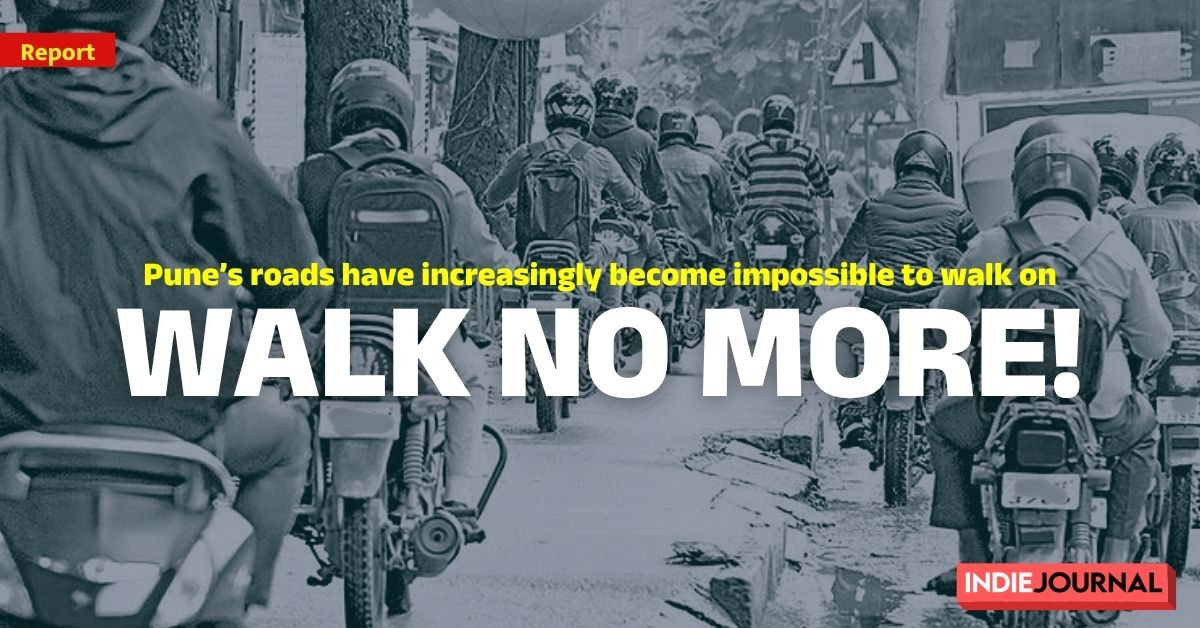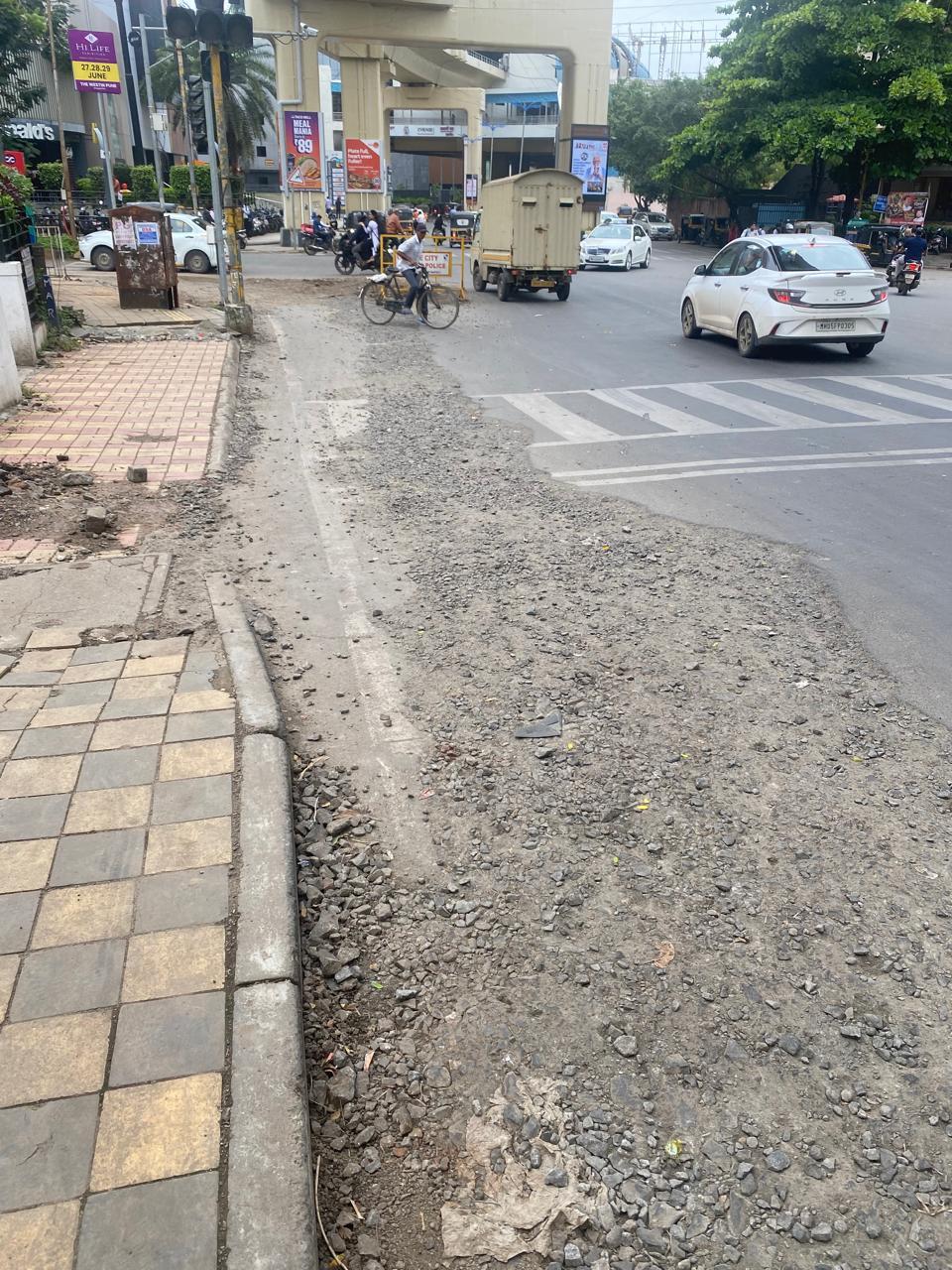India
Pedestrian distress on Pune roads
Pune’s roads have increasingly become impossible to walk on.

Kavyaa Masurkar | The constant state of peril that pedestrians face in the city has been a longstanding issue. Citizens complain that the unsafe footpaths, reckless driving, encroachments and poor infrastructure are turning the basic right to walk into a daily struggle. Despite being the most vulnerable road users and travellers, they say that pedestrians are consistently overlooked in the city.
“Around 10-15 years ago, we could walk anywhere without fear,” recalls Yasmin Charania, a resident of Kalyani Nagar. “Now, even stepping outside my society feels risky. Policymakers talk about progress, but our basic right to walk safely is gone.”
It’s a sentiment echoed across neighbourhoods, including residents from several busy parts of the city voicing out their concerns. On many roads, footpaths are either dug up, encroached or simply nonexistent. And when they do exist, they are rarely maintained. “This footpath is supposed to protect us,” says Monica Sharma, gesturing toward a narrow stretch cluttered with garbage bins and junction boxes. “During the monsoon, it floods so badly that we are forced to walk on the road. It’s not just unsafe, it’s humiliating.”

Broken foothpath. Photo: Kavyaa Masurkar
The numbers clearly underline the danger. The Times of India Pune, in its report published on September 15, 2025, stated, “In the first six months of this year, approximately 70 pedestrians have been killed in accidents on city roads. During the same period last year, 65 pedestrians lost their lives, effectively causing a rise in fatalities year-on-year.”
The TOI also reported that in the entire span of last year, 119 pedestrians lost their lives in road accidents. Additionally, in 2023, this number was estimated at 121 pedestrians as per figures released by Pune Traffic Police.
Architect and academician Jagdeep Desai, a former member of the Unified Mumbai Metropolitan Transport Authority (UMMTA), mentions that the problem starts well before people step onto the footpaths.
“Bureaucrats and planners probably haven’t walked more than 100 metres at a stretch anywhere in India,” he notes. “Roads are described in widths, but those dimensions rarely include footpaths or cycle tracks. Pedestrian refuge islands, raised crossings and traffic calming features, all standard in global cities, are almost nonexistent here.”
पुणे शहरात वडाच्या डोलीतुनच पलीकडे जाव लागत तरी असा पादचारी मार्ग कुठे आहे ते पुणेकरांनी ओळखून ते ठिकाण कमेंट मध्ये सांगाव.बरोबर उत्तर देणाऱ्यास माझ्या सोबत हाॅटेल पांचालीत जेवायला याव लागणार आहे. pic.twitter.com/YkNfT6UaIg
— Suhas Nimhan (@mns_suhasnimhan) June 10, 2024
He pauses, his frustration palpable. “Even after the Rights of Persons with Disabilities Act, 2016, which mandates accessible infrastructure, implementation is nearly absent. Ramps, textured tiles and sound-based guidance should be basic standards. What’s missing is genuine intent, not policy on paper.”
Residents’ experiences confirm his observations. In Koregaon Park, Rohan Desai of the Residents Welfare Association says, “Footpaths from Ruby Hall Metro to Koregaon Park are dominated by bikers during evening hours. Women returning from the metro face real danger. Rickshaws refuse short rides, so people are forced to walk right into traffic. Senior citizens have simply given up evening walks.”
Despite repeated assurances about last-mile connectivity from the PMC, he adds, “It’s all on paper. The traffic department fines citizens for minor offences but ignores drunk drivers from nearby bars. Moreover, our education system doesn’t teach civic sense. There is clearly a huge gap between what is planned and what is implemented."
Nikhil Mijar, Transport Planner in the Road Department of the Pune Municipal Corporation (PMC), acknowledges the challenges, noting that road construction in Pune is inherently complicated due to the city’s dense traffic. “I am a citizen first, before being an official,” he says, “and I observe the issues with footpaths every day. The reality is, PMC does not have unlimited funds or resources to constantly repair them. Maintaining footpaths is a continuous challenge.”
He adds that enforcement must be a shared responsibility. “Traffic police need to ensure two-wheelers don’t drive or encroach on footpaths, and citizens also need to exercise basic civic sense. Two-wheeler drivers are impatient, they cannot wait for a few seconds at signals and choose to ride on pedestrian paths. Until pedestrian safety becomes a shared responsibility in our city, we will unfortunately risk staying in this vicious cycle of inconvenience and danger.”
.jpeg)
Two-wheelers parked on Pune's footpaths. Photo: Kavyaa Masurkar
However, for many citizens, “shared responsibility” feels like abandonment. “I don’t see officials walking through open drains or missing slabs to work,” Charania mentions. “They talk about apps and plans, but on the ground, it’s chaos.”
A recurring complaint among residents is the impracticality of pedestrian bridges and subways. “Why would anyone climb the equivalent of three floors up and down when you can cross the road directly?” asks Harshad Abhyankar, Founder and Director of Pune Save Traffic Movement.
“Humans are built to walk, not climb.” Abhyankar further says, “The city has around 250 traffic signals, with 125 covered under the ATMS project. Most of these have pedestrian signals, but they are not properly maintained. In contrast, issues with vehicular signals are promptly reported by the traffic police and fixed by PMC, which clearly shows where the focus lies. At older, traditional signals, pedestrian signals barely function — our study four to five years ago found only 15–20 percent working, and I don’t believe the situation has improved much since then.”
Pune - Footover Bridge are built for "Birthday Wishes of NETAs" not for pedestrian..
— Abhishek Chouhan (@abhishekchouhan) December 29, 2010
Mijar, however, claimed that the PMC is prioritising and making ongoing efforts to improve infrastructure for pedestrians. “We have developed 700 kilometres of footpaths in the city and are working hard to provide better solutions, both in terms of design and implementation. NGOs like WRI, ITDP, Parisar, BVLF and the Bloomberg Foundation are helping PMC with capacity building and system reforms. Moreover, under the Urban 95 Programme, with the help of these NGO’s, we are prioritising to safeguard the mobility of young children within the city.”
He adds, “On the technological front, digital reforms like the PMC Road Mitra app and a new trenching permission app are helping improve accountability. Through the Road Mitra app, citizens can upload pictures of issues such as damaged footpaths, potholes, waterlogging or drainage problems. These complaints are assigned to the responsible engineers and progress can be tracked digitally. If the repair work is not completed within the mandated 72 hours, the engineers are held accountable.”
Raja Subramani, a Viman Nagar resident, stresses the need for design that respects human behaviour. “People will not walk 100 meters just to find a crossing,” he says. “If it’s inconvenient or unsafe, they will risk crossing where they stand. That’s why FOBs and underpasses must be clean, well-lit, staffed and equipped with escalators or ramps. Otherwise, they are useless.”
“European models have tactile paths, audio signals and consistent curb ramps. All these can be adopted in Pune."
Raised pedestrian crossings, which allow pedestrians to cross at footpath level while slowing traffic, are another solution he advocates. “These are simple fixes that help everyone — walkers, children, the elderly and differently-abled citizens. Yet, they’re rarely implemented.” Desai also echoed the sentiment, stating, “European models have tactile paths, audio signals and consistent curb ramps. All these can be adopted in Pune, if there is political will and citizen awareness.”
Additionally, for the differently-abled, walking in Pune is especially hazardous. Abhyankar explains, “Blind pedestrians need tactile paving that’s functional, not decorative. Audio signals at crossings can indicate when it’s safe. Even hearing-impaired pedestrians rely more on visual cues. If we design for everyone, including the differently-abled, it benefits the entire city.”
Mijar states, “Towards this concern, PMC is proactively working on infrastructure solutions and accessibility for the differently-abled. We are following Supreme Court guidelines to aid persons with disabilities and the visually impaired. We also conduct annual sensitisation sessions with NGOs such as Ekansh to ensure awareness and adherence.”
Jagdeep Desai also pointed out that legal frameworks exist but remain largely unimplemented. “The 2016 Rights of Persons with Disabilities Act replaced the older 1995 law. It mandates accessibility, but on-ground enforcement is weak. A lot of work is needed, and it starts with genuine interest and understanding, not just technical guidelines.”
In Koregaon Park, the challenges are evident at a local blind school. “They have large speed breakers, but mostly rely on manual help,” Rohan Desai says. “That’s not enough. Safe infrastructure must be consistent, integrated, and maintained.”
Building on her concerns, Charania emphasises and outlines practical solutions that she believes could make the city safer for pedestrians stating, “Some basic things that would enhance pedestrian safety could be bringing back speed breakers on all roads, zebra crossings at various points, subways specifically designed for pedestrians like we have at Churchgate in Mumbai, CCTV monitoring of busy intersections, huge fines for drivers not following traffic rules like stopping behind zebra crossings, harsh punishments in pedestrian deaths when it is proven that the driver was clearly at fault and regular awareness campaigns on pedestrian safety.
Crossing for pedestrians is dangerous. Though pedestrian signal works vehicles never follow it.
— Dr. Lakshmi Nilakantan (@DNilakanta57685) September 10, 2024
Location : Seasons mall , Magarpatta, Hadapsar, Pune, MH 411028@PuneCityTraffic @CPPuneCity @PMCPune pic.twitter.com/b4EUiHwzv7
Abhyankar added that zebra crossings also remain in poor condition. “The conditions of zebra stripes have also remained bad. PMC will blame it on the monsoon and ask for two to three months to paint those, but the situation is not much different in January to May as well.”
DCP (Traffic) Himaat Jadhav explains that enforcement and infrastructure improvements are not simple tasks in a city with rapidly growing traffic volumes.“We issue over 4,500 challans daily through CCTV and e-challans. We are upgrading zebra crossings, adding pedestrian signals and clearing encroachments. However, the public needs to realise that the congestion is not created by us. Pune has 80 lakh people and 72 lakh vehicles and our officials are trying their best to bring order.”
He further says, “We have launched our own app, PTP (Pune Traffic Police), available on the Google Play Store. Citizens can report violations by uploading photos. An automatic challan is issued within 12 to 24 hours and both the violator and the reporter receive the message.” “Furthermore, regarding encroachments, we are acting against footpath encroachments, driving on footpaths, and footpath parking.“In our traffic office, we monitor not only CCTV cameras but also Google Maps and wireless sets. We track minute-to-minute speeds on 32 major roads, recording per-hour and per-day averages. Every inch of road is being monitored by my team.”
The narrative across Pune is consistent: laws, policies and plans exist, but implementation falls short. The PMC’s smart city initiatives, traffic management apps, and pedestrian schemes sound promising on paper. However, residents’ frustration and expert critiques reveal that there is a clear gulf between policy and practice. Sharma highlights and sums it up powerfully, “A truly progressive city is measured not by the number of vehicles it accommodates, but by how safely and comfortably its people can walk. Clean, unobstructed and well-regulated pedestrian spaces must therefore be treated as a fundamental necessity, not an afterthought.”






